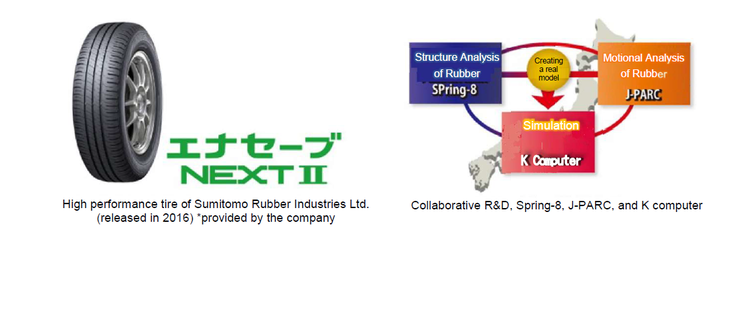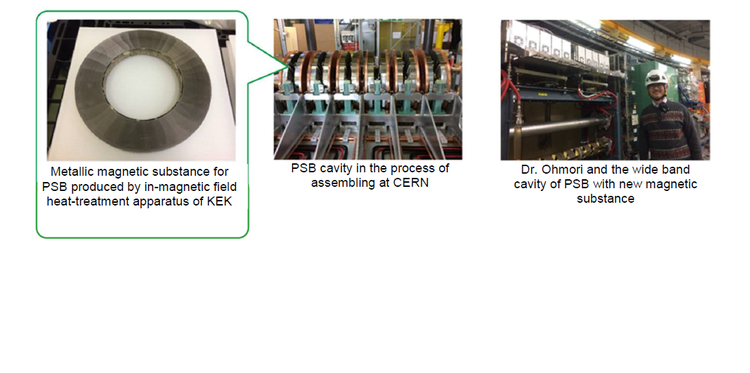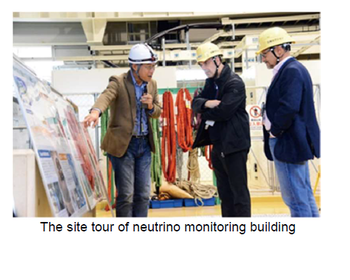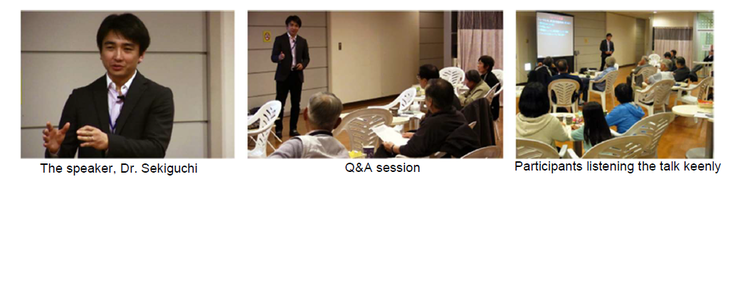J-PARC NEWS November 2017 (Issue #151)
■ Sumitomo Rubber Industries Ltd. Received the Highest Award at the "27th Nikkei Global Environmental Technology Awards" (October 13)
Sumitomo Rubber Industries Ltd. won the highest award at the "2017 Nikkei Global Environmental Technology Awards" from Nikkei Inc. for the development of the fuel-efficient tire "ENASAVE NEXT II". This award is given by comprehensively judging originality, prospects, and potential for technological development, research, etc., which aim to establish a sustainable global environment, such as a resources/materials environment. Sumitomo Rubber Inc. co-utilized the high power proton accelerator facilitates of J-PARC, a large synchrotron radiation facility SPring-8 and the K computer to establish new material development technologies for tire rubber. While maintaining the high levels of fuel efficiency and grip capability of their original tires, they were able to increase the wear resistance by 51%.
■ Successful observation of spin arrangements using neutron transmission~ enhanced flexibility of equipment design compared to the conventional neutron diffraction measurement and easier observation of undiscovered spin arrangements~ (November 17, press conference)
The National Institute for Materials Science collaborated with the Japan Atomic Energy Agency and J-PARC and used the Neutron Beamline for Observation and Research Use (NOBORU) at MLF to successfully observe electron spin arrangements of a material for the first time in the world, by measuring how much injected neutron beams are transmitted through the sample. Transmitted neutrons can be observed in a straight line between the neutron beam sources and the sample. Thus, it becomes easy to install devices that create multiple extreme conditions, such as high pressure and high magnetic field, etc. where some spin arrangements are yet to be discovered. There is the prospect for new material developments by spin manipulation . Part of this research received Grants-in Aid for Scientific Research 15K13278 from the Japan Society for the Promotion of Science. The research result was published in the on-line version of the Scientific Reports by Spring Nature in November 14, 2017.

■ J-PARC Workshop “Deuterated Materials Enhancing Neutron Science for Structure Function Applications" (October 19-20, IQBRC)
Aiming to invigorate neutron science research with deuterated materials, "J-PARC Workshop ~Deuterated Materials Enhancing Neutron Science for Structure Function Applications~ " was held at the Ibaraki Quantum Beam Research Center. The workshop invited 3 researchers from overseas, ANSTO National Deuteration Facility (NDF) research fellows, Dr. Tamim A. Darwish (chemical deuteration) and Dr. Anthony Duff (bio-deuteration), and Dr. Anna Leung (chemical deuteration), a research fellow of DEULAB (the chemical deuteration laboratory) at ESS. Joined by deuteration researchers and neutron scientists of Japan, altogether 62 researchers discussed focusing on development strategies of deuteration research at J-PARC. On deuteration technologies, ANSTO-NDF, DEULAB of ESS , and Professor Sajiki's research group of Gifu Pharmaceutical University gave talks on their research achievements, pointing out the importance of the introduction of a large-scale reactor for deuteration and its analytical instruments. During a talk on science, opinions were expressed such as, the necessity to find methods for easier sample deuteration. This meeting provided a good opportunity for the deuteration technology researchers and the users of the technologies to deepen their understanding of each other. During a free discussion, participants discussed the benefits of introducing an apparatus for large production and analytical instruments, potential cooperation with a European deuteration network, and formation of a deuteration community in Japan. In addition, they talked about inclusion of other fields, such as cooperation with the nuclear magnetic resonance field. Their discussion included many themes in relation to the invigoration of neutron science research using deuterated materials. The workshop ended with great success.
■ Contribution to Accelerator Upgrade in Europe and Japan – Production of metallic magnets used also at CERN
State-of-the-art accelerators explore the extreme conditions of nature with superior advanced technologies. They are destined to have various improvements in order to increase power. Professor Chihiro Ohmori of the High Energy Accelerator Research Organization (KEK), which is a part of the J-PARC Center, and his Ring radio frequency acceleration (RF) group have developed a production apparatus for metallic magnets with a high-electric-field gradient which is necessary for the RF system. These magnets have been used for the accelerators at J-PARC as well as the European Organization for Nuclear Research (CERN), helping to increase power of accelerators in Japan and Europe. CERN is planning to replace the accelerating cavities , which include the magnets, in order to increase the power of its proton beam injector, the PSB (Proton Synchrotron Booster) proton accelerator of LHC (Large Hadron Collider).
■ Ibaraki Prefecture Governor Kazuhiko Oigawa Visits J-PARC (November 20, J-PARC) On November 20
Ibaraki prefecture governor, Kazuhiko Oigawa visited to take a tour of J-PARC. During his visit, the J-PARC Center director, Naohito Saito, gave an overview of the facilities, and then, at the MLF Experimental Hall, the Ibaraki Neutron Beam Line project leader explained about its neutron experiment devices, mainly on iMATERIA and iBIX. After that, he was given a tour of experimental devices for technology development, in progress at J-PARC, in regard to lead-bismuth which is a target and coolant material for an accelerator driven nuclear transformation system. He was listening intently to the explanation on the technology development given by Toshinobu Sasa, the leader of the Target Technology Development Section of the Nuclear Transmutation Division.
■ KEK-CERN Committee to plan Neutrino Experiment Cooperation (October 31, KEK Tsukuba Campus)
The European Organization for Nuclear Research (CERN) is planning an upgrade of the Large Hadron Collider (LHC) after 2019. Neutrino experiments have been conducted at CERN as well as at J-PARC. Representing his group in this meeting, KEK Professor Takashi Kobayashi, division head of the Particle and Nuclear Physics Division, gave a presentation on the plan for neutrino experiment cooperation at J-PARC. The committee members took a tour which included experiment facilities of Neutrino, Hadron, and MLF.
■ JAEA President's Awards for the FY 2017 (November 6, JAEA Atom World)
At the commencement of the Japan Atomic Energy Agency (JAEA) President's Awards of FY2017, a dynamics analyzing instrument group, consisting of 7 researchers including Kaoru Shibata from the Neutron Instrumentation Section, was awarded the "Research and Development Prize". It was for "constructing the Dynamics Analyzing Instrument DNA and initiating research utilizing the instrument", which helped to complete groundbreaking research and development. Also, Koichi Sato of the Radiation Safety Section was given an "Exemplary Achievement Prize " for his work to "complete sharing system of radiation monitoring information at J-PARC".
<<J-PARC-related Winners>>
[Research and Development Prize (Achievements pertaining to completion of groundbreaking research and development)]
Achievement: "Constructing the Dynamics Analyzing Instrument DNA and initiating research utilizing the instrument",
Dynamics analyzing instrument group: Kaoru SHIBATA, Yukinobu KAWAKITA (Material and Life Science Division, Neutron Instrumentation Section), Hiroshi NAKAGAWA (Materials Science Research Center, Neutron Material Analysis Division, Hierarchical Structure Research group), Wataru KANBARA (Nihon Advanced Technology Co., Ltd.), Takeshi YAMADA, Masato MATSUURA, Taiki TOMINAGA (Comprehensive Research Organization for Science and Society (CROSS) Neutron Science and Technology Center).
[Exemplary Achievement Prize]
Achievement: "Completion of a sharing system of radiation monitoring information in J-PARC”
Koichi SATO (Safety Division, Radiation Safety Section)
■ 10th J-PARC Hello Science "From Tokai to the World! The Latest Achievements of Neutrino Experiments" (October 27, Tokai-village Industry and Information Plaza "iVil")
At the 10th Science Café on October 27, Tetsuro Sekiguchi from the J-PARC Center's Neutrino Section gave a talk on the latest achievements of the T2K (Tokai to Kamioka) experiment. In the T2K experiment, high-intensity neutrino beams are shot out from J-PARC to be caught at Super-Kamiokande (SK) in Kamioka-cho Hida-city Gifu-prefecture, in order to reveal the mystery of the characteristic differences of particles and antiparticles (CP symmetry violation). He reported that previous experiments with neutrino beams and anti-neutrino beams started to indicate CP symmetry violation occurring with 95% probability. In addition, he explained that increased beam intensity and the construction of Hyper-Kamiokande are necessary for experiments that supply more data. The audience had many questions as well.







